
 |
|
|
#1 |
|
Member
Join Date: Apr 2007
Location: Nothern Mexico
Posts: 458
|
Hi, ´
A friend of mine, Martha, an advanced student in restoration, found a duble dagger in an Army Museum in Mexico, classified as an "Indian Haladie". Neverthless, she has been making some research to check this label, and she has found that there are also haladies classified as sudanese. Here, we have a very intersting subject related with the origin and use of the concept of "haladie". The dagger in question seems to be related to those classified as "sudanese", and not "indian" or "hindu". But the question it aroses is if haladies are, or not, of indian origin. If so, why we can found sudanese haladies, and not haladies in other part of the world, as far as we know? Were haladies an indian export? Or sudanese people developed another kind of "haladie"? If so, is it valid to call it also a "haladie"? Is the concept "haladie" a generic concept valid for all kind of weapons with doble or triple blade, with two oposed blades in this manner, at least? George Cameron Stone (p. 275 from the 1999 edition) mention the rajput origin of the haladie, and only refers as third party, to an Egerton description as a weapon also used in Syria. But I was unable to find other descriptio of the origin of this weapon in Egerton, but as an arm from Egypt and Sudan (Egerton, p.168, Cat. number 189, 2002 edition), and though there is a descrption of this weapon in the number 390 of the general index of illustrations, I couldn´t find this illustration itself. I wonder if the extensive influencie of indian arsenal in the arab world, mentioned by S. Lane Pool in "Art of the Sarracens in Egypt", in the 1871 edition, and quoted by Lord Egerton, has anything to do with the making of this weapon, and if India made "trade blades" of this kind for the arab world. In the following picture, we can see the weapon. It is similar to a weapon showed in Therion Arms, also classified as haladie, but the calligraphy is very different. I also would ask your support to translate this inscription as an aide to classify the weapon. All your comments will be very welcomed. Thank you: |
|
|

|
|
|
#2 |
|
Member
Join Date: Jan 2006
Location: Kent
Posts: 2,658
|
Hi Gonzalo G,
the example you have shown looks to be sudanese....similarly made daggers are often attributed to the Sudan. For example.. http://www.vikingsword.com/vb/showth...ighlight=sudan There was alot of trade in the Sudanese area and India, especially after the construction of the Suez canal...... http://66.102.9.104/search?q=cache:M...lnk&cd=4&gl=uk I feel the 'sudanese' haladie was a copy of the Indo persian version... a particular type of Indo-persian mace/staff also has Sudanese versions (that do not seem to appear in other parts of Africa.) Either these variations were introduced by 'trade links' or perhaps Islamic Indians sympathetic to the Mahdi brought these to the Sudan  The picture of the first mace is Indo persian ....the second is Sudanese Regards David |
|
|

|
|
|
#3 |
|
Member
Join Date: Feb 2006
Posts: 637
|
often on Sudanese pieces the script is qoranic. Since many of the makers were illiterate the passages are copied Many times starting in the middle of a sentence and ending when they ran out of room
|
|
|

|
|
|
#4 |
|
Arms Historian
Join Date: Dec 2004
Location: Route 66
Posts: 10,663
|
Hello Gonzalo,
If I may say so, I would like to both thank you as well as congratulate you on your brilliant posting of this indeed intriguing weapon. It seems that there have been a number of inquiries on a broad spectrum of historic edged weapons coming from several museums in Mexico, and it impresses me that such a serious approach to the study of these weapons is being observed. This is especially pleasing as in these times it seems that in too many museums, weapons are simply thrown into storage or worse, displayed with terribly inaccurate descriptions. What is even better is that you have not only presented this weapon, the 'haladie', with known material concerning it, and fully referenced, and best of all you have asked the key question, from where might this weapon have evolved. In response, I would say that the multiple bladed weapons were indeed quite prevalent among weapons produced by Indian armourers, and we have discussed here katars with as many as five blades, though more common are the triple bladed examples (for more see "Hindu Arms and Ritual" by Robert Elgood, as well of course as Stone, 'katar'). The 'haladie' is likely of course associated with the 'madu' which is essentially comprised of two buffalo horns fastened together opposed as seen with haladie blades. While the madu of horns was primarily something used by religious mendicants and holy men termed 'fakirs' because they were not allowed weapons in the true sense, and these makeshift weapons were comprised of natural items (horns) . The Rajputs may well have applied the double blade concept, as it was well established that these were deadly in crowded conditions, thus would serve well in dismounted melee, and they fashioned thier own version using the deadly blades of the 'bichwa'. The thuluth script on your haladie, if I understand correctly , was often incomprehensible literally and comprised symbolized calligraphy that was intended to typically illiterate tribesmen during the Mahdist period in Sudan (please correct if my understanding of the thuluth is wrong  . In any case, the script was acid etched in armouries in either Khartoum or Omburman. . In any case, the script was acid etched in armouries in either Khartoum or Omburman.India did indeed export many weapons to Arabia and Africa, through the Arab trade on the Malabar Coast. I am not aware of any examples of haladie made in India, however it is clear that the weapon itself in concept certainly is likely to have come from there. The weapons of Sudan reflect other weapons in thier armouries as well, and there are yataghans, the axes and others that arrived via other Ottoman trade sources. What has always surpised me is that despite the vast diffusion to Sudan and other regions in Eastern Africa of many weapons, that as far as I know, the tulwar is never represented among them. Thank you so much for posting this haladie, and the opportunity to discuss it. All very best regards, Jim Last edited by Jim McDougall; 18th January 2008 at 04:45 PM. Reason: missing words in sentences |
|
|

|
|
|
#5 |
|
Member
Join Date: Apr 2007
Location: Nothern Mexico
Posts: 458
|
Katana, I feel inclined to agree with you. Ward, very interesting your notation about those inscriptions. Jim, thank you for your kind words. I never thinked about the relation of the madu with this weapon, but as you pointed to it, it seems obvious. Very good point. It is also a very good point, to observe the absence of the tulwar in the Sudan arsenal. I thank you for your wise comments and attention to this thread. Your help was very valuable.
My best regards Gonzalo G |
|
|

|
|
|
#6 |
|
Arms Historian
Join Date: Dec 2004
Location: Route 66
Posts: 10,663
|
Thank you very much Gonzalo!
 I have sent you a PM. All the best, Jim |
|
|

|
|
|
#7 |
|
Member
Join Date: Dec 2004
Location: Europe
Posts: 2,718
|
Here is an Indian one.
|
|
|

|
|
|
#8 |
|
Arms Historian
Join Date: Dec 2004
Location: Route 66
Posts: 10,663
|
"I am not aware of any examples of haladie made in India, however it is clear that the weapon itself in concept certainly is likely to have come from there"
-in my original post. Jens, thank you for catching what was an obvious misstatement  What I had meant to say was that I was not aware of haladies made expressly for the Sudan, with the thuluth motif and so on. Obviously the Rajput haladies are well known, and most likely influenced the Sudanese examples indirectly, probably via the examples which came via Syria (as Stone references) or equally possible via the Arab trade in Malabar. While I caught some incomplete sentences and edited them, apparantly I wasnt awake enough to catch this, the most obvious error!  oops. oops.Thank you again Jens, All the best, Jim |
|
|

|
|
|
#9 |
|
Member
Join Date: Apr 2007
Location: Nothern Mexico
Posts: 458
|
There is no need to be sorry, Jim, I understood exactly what you did want to mean, as for the context of your words it can be deduced. I thought that obviously you have perfect knowledge of the indian haladis made for indian customers.
Jens, thank you for your support. Our friend, Andreas, talks often about you. I will treasure your image in my PC. My best Gonzalo |
|
|

|
|
|
#10 |
|
Member
Join Date: Apr 2007
Location: Nothern Mexico
Posts: 458
|
On the other side, I think the presence of the haladie in Sudan must be dated before of the Mahdi rebellion, as Egerton made his studies about those weapons before that time. It could be related to the time of the construction of the Suez Canal, but I don´t know if the coolies from India bring that kind of influences to Africa, or the influences came from another path. This only speculation, but I dont know the reach and level of all the indian people who went to that construction. I can only be sure of the presence of the most basic level of handworkers. Of course, I can be wrong, and if somebody has better information, please feel free to post.
Neverthless, and as Jim noted to me, "Egerton wrote in 1880, prior to the fall of Khartoum, but did revise his catalog some years later after British campaigns in the Sudan and in fact those revisions do include certain Sudanese weapons." So, the question still remains open: from what time period, and from what means, the indian influence began to be felt in the Sudan arsenal, and the first haladies begin to appear? My best regards Gonzalo Last edited by Gonzalo G; 19th January 2008 at 08:09 AM. |
|
|

|
|
|
#11 |
|
Member
Join Date: Dec 2004
Location: Europe
Posts: 2,718
|
Gonzalo,
The maru is inscribed on both sides of the two blades, but unfortunately most is worn off. However the year is still there 1221 (1806 AD). Please give Andreas my regards. Jens |
|
|

|
|
|
#12 |
|
Member
Join Date: Dec 2004
Location: What is still UK
Posts: 5,924
|
Gonzalo, this thread gives me the opportunity to show two of my most inspiring pieces. Clearly there is Indo-Persian link or perhaps a Persian-Indo-Islam link as the triangular stiletto blade covered in script appears to be found from the Sudan to Indonesia. I think the link is more to do with Islam as the Indian decoration is quite different with inlays, depictions of people and on the whole floral in sentiment.
There have been examples of the "Islamic" stiletto shown in other topics. The stiletto has loose form of this script based decoration like the example you show. The axe shown here has a more tight version which frames the Arabic script most successfully, the hook is decorated in the same manner. The halft and the spear point are done in a more loose version.    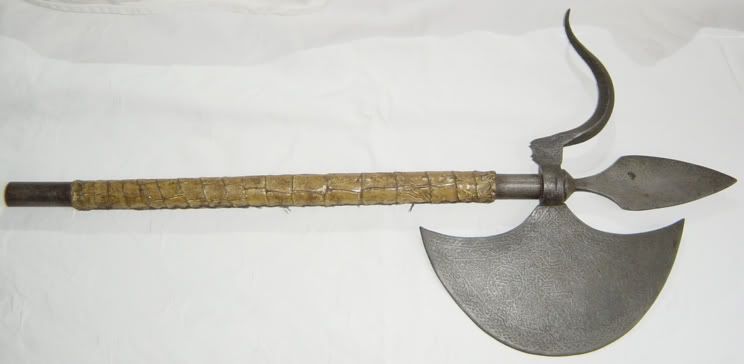 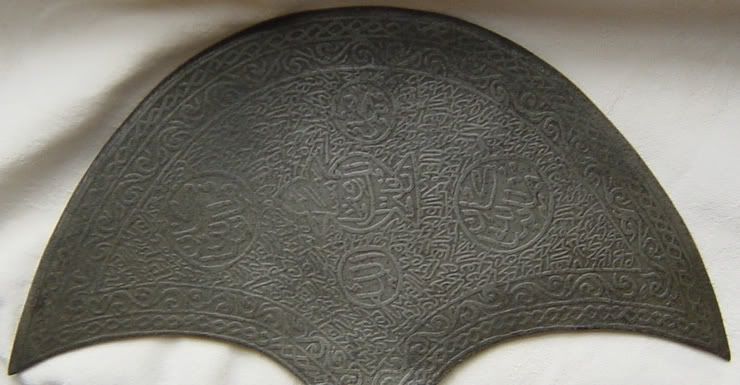 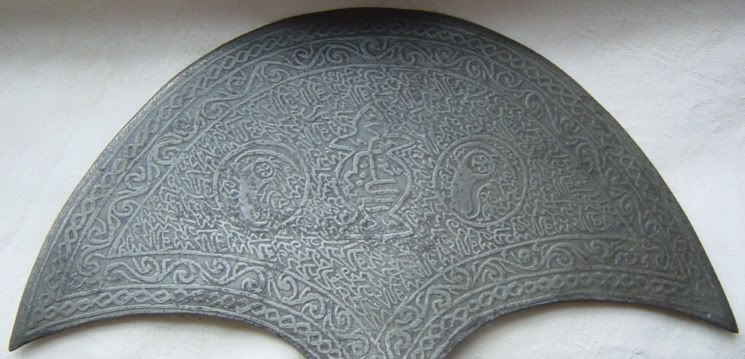
|
|
|

|
|
|
#13 |
|
Member
Join Date: Apr 2007
Location: Nothern Mexico
Posts: 458
|
Jens, thank you very much for your data and picture. I will give your regards to Andreas, and mention the help you gave me.
Tim, yours is a relevant contribution to the study of this influencues, documented in this pictures. I appreciate your participation. Thank you. All the best Gonzalo |
|
|

|
|
|
#14 |
|
Arms Historian
Join Date: Dec 2004
Location: Route 66
Posts: 10,663
|
Tim, thank you for posting these outstanding Sudanese examples that show key differences in the type of Islamic script and decorative motif.
The stiletto seems relatively unrepresented in most Sudanese weapons groupings I have seen, and this is a great example that illustrates that there are more weapons than the standard forms shown. The decoration on the axe recalls that seen on Mamluk weapons and material culture, and it would seem that perhaps a great deal of influence from the Mamluks found its way into the Sudan prior to the Mahdiyya. The crescent shaped head on the axe as well as the spear head atop is somewhat similar to forms from 18th century Malabar regions in India (Stone, fig.101, #6), and the curious recurved spike in place of the poll at the back seems of Indian influence also. As has been noted it is difficult to determine with any certainty the routing and sequence of such diffusion of influences, however the similarities in the elements of the weapon reflect reasonable probabilities. The use of crocodile hide and sometimes, as seen on the stiletto, the foot of a crocodile on hilts is something that appears to have been quite characteristic in the Sudan in weapons. Over the years there have been many discussions concerning this practice, and often there have been the usual suggestions that these weapons were fabricated for the tourist trade. I do not feel this is the case, and examples shown provenanced from the Mahdist period and likely prior seem to have applied crocodile hides to weapons as highly symbolic, with these reptilians both feared and revered for thier power. This was once expressed to me by a gentleman who was of the Fur, and from Darfur. Most Darfur kaskaras I have seen carry a strip of crocodile on the grip of the hilt. Returning to the original weapon posted here, the haladie. It seems that discussions in some cases have considered that in the Sudan, these may have been considered in a more ceremonial sense. In some material it was further suggested that the dual blades may have corresponded to that characteristic of Dhu'l Faqar, even though this is clearly not a sword, but may have represented the concept. As mentioned, the Mamluk influence seems well established, and in thier art they often used ivory, as well as the intricate Islamic motif in the metalwork. Since these haladies had white (bone) handles, this may correspond to the use of ivory, and the thuluth represented the intricate motif seen in the metalwork. I have seen Sudanese 'alem' (huge polearm spearheads used as standards) which carried such intricate metalwork as seen on the axe posted, and chiseled representation of an Islamic ewer. It would seem that while influences of a number of weapon forms in the Sudan most probably arrived via Arab trade from the Malabar coast, the decorative influences of Mamluk weaponry may have had influence in degree on thier aesthetics and symbolism. Best regards, Jim |
|
|

|
|
|
#15 |
|
Member
Join Date: Dec 2004
Location: Europe
Posts: 2,718
|
Gonzalo,
You must remember that trade between India, Arabia, Africa and the Mediterranean was rather intense from the second century AD, if not before, both by caravan and by sea – just as the trade between India and SEA are was. This leads to that weapons from one country can have been adopted as they were, or modified to the ‘new’ market. The only Indian weapon, which as not adopted by others, was the katar, which is strange, as it is a very powerful weapon. Blade were sold, and copied in the different countries, but there is one thing which does not seem to have been copied, and that are the hilt, although it is difficult to be quite sure with the very early types. Jens |
|
|

|
|
|
#16 |
|
Member
Join Date: Jan 2006
Location: Kent
Posts: 2,658
|
I have not been able to find Arabic versions of the haladie or the mace that I posted. Has anyone seen or knows of such versions.....if there are none...perhaps there was a more direct link between India and the Sudan.
Perhaps it was slaves that was one of the main commodities of the Arabic trading routes. Indians taken to the Sudan  Arab slave trading was rife and the Sudan was a good market to sell. Perhaps some of these slaves brought the haladie design with them Arab slave trading was rife and the Sudan was a good market to sell. Perhaps some of these slaves brought the haladie design with them  Bearing in mind that the value of a slave was not just physical health but skills or knowledge they pocessed. Bearing in mind that the value of a slave was not just physical health but skills or knowledge they pocessed.
|
|
|

|
|
|
#17 |
|
Arms Historian
Join Date: Dec 2004
Location: Route 66
Posts: 10,663
|
Actually I am not aware of Arabian versions of the haladie, despite the fact that they were quite clearly known in Syria (as noted in Stone) and it is well known that many edged weapons for Arabia came from Syria (Damascus, which was an established trade hub).
The slave trade in Sudan seems to have focused more on captured individuals from tribes to the south of Sudan, and the trade routes through the interior that extended from Zanzibar, also a slave trade center. It is always fascinating to review the trade networks, those from the sea, then into the interior, and ultimately transcontinental via Saharan routes. The complexity and vast distances are amazing, and through the Sahara particularly are compounded by nomadic movement and tribal interaction that may account for many instances of weapons diffusion. It is indeed quite interesting that the katar never seemed to gain acceptance in regions outside India, as well as previously noted, the tulwar. Yet, the noteably unusual haladie did become accepted in the Sudan, while remaining unrepresented in other places that certainly, as David has noted, experienced considerable trade and commerce with India. I am inclined to believe that the haladie in the Sudan became established as more of a ceremonial and votive item as previously noted, with the association with dual blades of Zulfikar. It seems in discussion some time ago there was a dagger from the Sudan with a curious mark on the blade, a very stylized 'S' type mark, and I suggested that the mark may represent the haladie, noting its established regard ceremonially, and possibly used as a maker or armory mark. At this point no other examples have surfaced to support the idea..but one never knows. As for the katar, its origins remain as mysterious as the term itself. While the term 'katar' also applies to a standard form dagger in northern India, it is suggested in Pant that Egerton erred in using the katar term, when it should have been 'jemadhar' (all considerable previous discussions). Stone shows the even more mysterious 'Moorish' gauntlet sword the 'manople' but does not suggest any association to the katar or pata (yet more discussions). With the manople, it remains one of the few known example of transverse gripped edged weapons outside India, and the example in Stone is believed a singular example that was held in the Royal Armoury in Madrid (Calvert). It would seem that the 14th/15th century attribution by Stone would be a bit optimistic, and more likely that it would have been influenced by either the Indian katar or pata at somewhat later date via trade from India, rather than this single weapon influencing an entire genre of transverse gripped weapons there. Another curious instance of transverse grip 'push dagger' would be the 'T' handled form used by gamblers in San Franciscos "Barbary Coast" in the mid to late 19th century. No direct association has ever of course been established with the katar...however the ships that came to this intensely busy port in those times were from around the world, and the trade would have certainly brought exotic items from faraway places..including India. Best regards, Jim |
|
|

|
|
|
#18 |
|
Member
Join Date: Dec 2004
Location: What is still UK
Posts: 5,924
|
Now I will break some collector lore. Information gleaned from, Nigerian Panoply arms and armour of the Northern Region. Collectively we assume these things, some dismiss such things, as Sudanese. Well they may well not be. One will also have to bring to mind the conflicts with Emirs in the region of Kano and the other Islamic states of Nigeria and the Sahel. I will keep this short as I cannot use a key board well. The script is thought to be Mamaluk inspired. There is general acceptance of arms trade north from Morocco and from Egypt but it is stressed that this was not a one way state of affairs. I would suggest the desert nomads in possession of a Tabouka obtained them from walled cities like Kano. Here are some pictures that solve a few questions. I have marked the appearance of the script to help. Note the sword is a Tabouka.
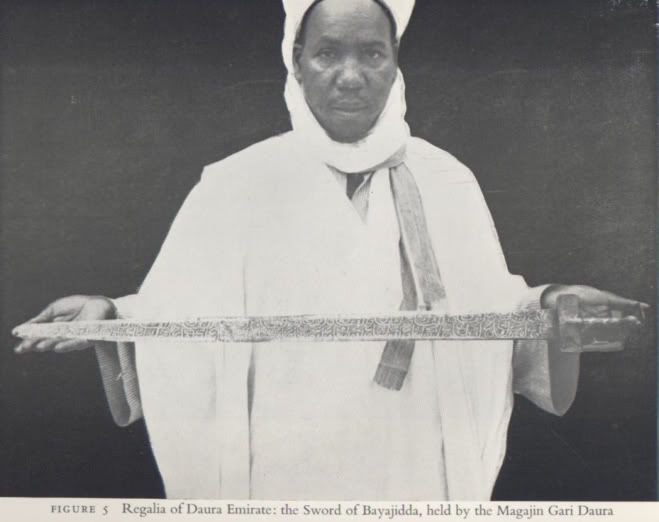 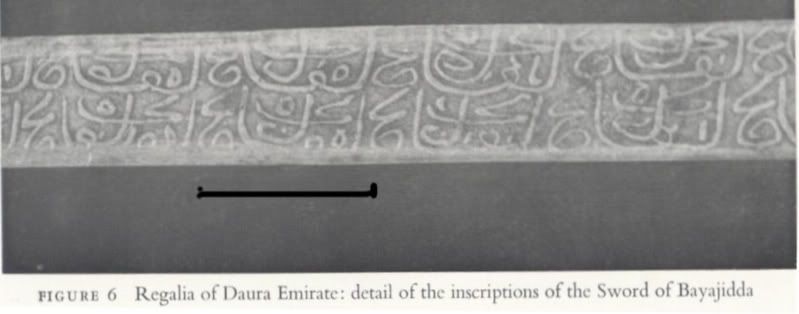 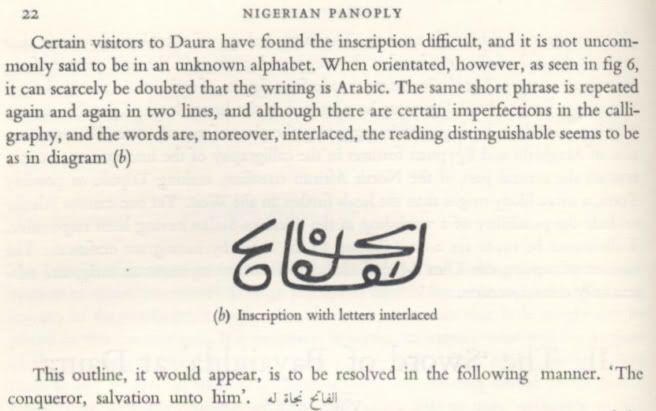 I have rotated this for a more clear image. 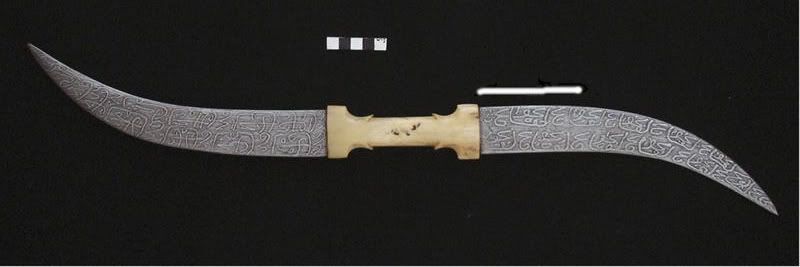  Even the scribble on the axe is a constant repeating of this alif? Last edited by Tim Simmons; 3rd February 2008 at 01:20 PM. Reason: smoothing out a few lumps |
|
|

|
|
|
#19 |
|
Member
Join Date: Dec 2004
Location: What is still UK
Posts: 5,924
|
I was so brief in the last post I feel I should add a little more about the script and origins of the sword in the photograph. There are notions of Medieval origins which hinder us today. A look through any of Oakeshott's publications should put an end to that. The sword is not Medieval. It is thought that the script is too inaccurate to have origins in an Egyptian workshop also it is held to predate the armoury at Omdurman. The origin is thought to be somewhere in Nilotic Sudan.
I am not a qualified historian or researcher so I could be talking from a hole in my backside. However I do think it is not unreasonable to face convention full on. You only have to think of the sack of Benin city 1897? and the refusal in believing that the art works there were locally made and of indigenous thought. The sword mentioned and other works may well be slowly emerging from this type of learned discrimination and we as collectors are often all too eager to accept this condition. One of the problems with this material, which affects opinion so much is that it is simple, not shiny, silvery and covered in glittering baubles. So untill quite recently its market value held back any further thought and care of investigation. I know I use strong words but it is fun. I simply cannot accept that cities like Kano in such an expansive land did not make weapons. Last edited by Tim Simmons; 3rd February 2008 at 06:01 PM. Reason: smoothing out a lump |
|
|

|
|
|
#20 |
|
Arms Historian
Join Date: Dec 2004
Location: Route 66
Posts: 10,663
|
Hi Tim,
Thank you for elaborating in more detail on the swords and weapons of these regions, and for your well placed line of thinking. It is interesting that it is often considered that the familiar 'thuluth' script seen on weapons is a distinct indicator that the weapon is Sudanese. As can clearly be seen, the takouba shown as from the regalia of the Daura emirate in Nigeria is profusely etched with this script. It is unclear if the blade is one of the countless trade blades that have been mounted in these swords, or if it is native forged, but it does seem quite possible to have been decorated in Nigeria. The thuluth script is of course derived from Kufic, the early script used to transcribe passages from the Qur'an, and was often used to apply such inscriptions as motif on many items of material culture. The Sudan and Nigeria were key regions of Islamic presence in North Africa and the use of this very beautiful calligraphy was in use from early times with Mamluk armourers, and thier decorative work certainly imitated in varying degree. I agree that it seems almost preposterous to presume that with the importance of the Emirates of Nigeria, and the constant trade across the Sahara, that these more remote places did not have the presence of culture and artisans comparable to the larger and more well known centers. It is now well established that Timbuktu, often jokingly used to describe the most remote desert emptiness, was actually a well travelled site for caravans and actually an almost 'Oxford' like center for Islamic scholars. There are huge libraries of lexicons of important works held there, and the city often portrayed as a mud daubed spot in the desert is now regarded as having been a very important center of medieval scholarship. Along with the constant movement of the caravans moved not only trade and wares, but scholars, artisans and the diffusion of art, and philosophy. In "Nigerian Panoply", I believe there is another sword shown by Bivar, which has a name beginning with a 'G', and like the one shown here, is considered an important item of regalia. I'm running on memory here as I do not have by copy at hand, so I hope you might check this. It seems like the sword I refer to appears to be a European hanger or sabre, but as noted, is highly revered as a 'sword of state' or of that stature. It would seem that the sword, as a weapon, was reverently regarded in Nigeria and in the case of the Hausa state of Zaria for example, the name derives from a famous sword named 'Zazzau'. These Hausa people (though the Fulani conquered in 1804) are called 'Zage Zage'.I am under the impression that the Hausas had swordsmiths, and if I am not mistaken are known among Tuareg swordsmiths, with certain examples of Sudanese kaskara attributed to the Hausa (see Briggs). The city of Kano was known for its ironwork as early as the 7th century. It does indeed seem quite possible that weapons were made in Kano. All best regards, Jim Last edited by Jim McDougall; 4th February 2008 at 12:55 AM. |
|
|

|
 |
|
|